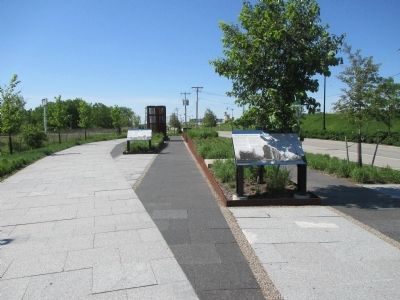First Ward in Buffalo in Erie County, New York — The American Northeast (Mid-Atlantic)
Fireproof Grain Elevators / Concrete Grain Elevators
The Industrial Heritage Trail
Inscription.
The frequent loss of elevators to fire and explosion prompted a search for safer building materials and construction methods. Experiments with fireproof materials centered on steel, tile, and concrete.
The Great Northern Elevator (1897) and Electric Elevator (1897) were the first to employ steel grain bins on a large scale, and the first to use electricity as a source of power. Electricity had become available from the Adams Power Plant in Niagara Falls in November 1896.
During the first decade of the 1900s, a number of other steel elevators went up on the Buffalo waterfront. These included the Dakota Elevator, the Great Eastern Elevator, the Iron Elevator, and the Monarch Elevator. Only the Great Northern Elevator still stands as of 2011.
Steel proved to be less satisfactory than originally envisioned as a fireproof material. While fire would not burn the metal, the heat generated by a grain fire could cause structural damage to the bins and the steel support structure.
Industrial engineers also experimented with ceramic tile in the early 1900s. Ceramic tile bins were completely fireproof and heat resistant, and their hollow walls were better than steel at insulating grain from the extremes of heat and cold. However, the tile structures were expensive to build and maintain. The large number of mortar joints needing to be dressed slowed the process of construction and afterward required constant vigilance to prevent leaks. Only two ceramic tile elevators were constructed in Buffalo: the Washburn Crosby "A" Elevator, erected in 1903 (still standing), and the Maritime Milling Elevator (now demolished).
[image] The Great Eastern and Dakota Elevators, circa 1900. The steel bins of the Great Eastern were exposed, while the bins of the Dakota were hidden behind a facade of corrugated iron panels. The City Ship Canal is on the right. Image Source: Library of Congress, Detroit Publishing Company
By the 1890s, concrete was already being used for the foundations and floors of wooden grain elevators. However, the era of the true concrete grain elevator began with the application of reinforced concrete for the construction of the storage bins. In 1899, the first reinforced concrete bin grain elevator in the United States was constructed in Minneapolis. It consisted of a single cylindrical concrete bin 124 feet high. The grain elevator was built using the slip form construction method, in which the form was raised by jacking rods as the concrete was poured, allowing for the steady rise of the slip form until the full height of the silo was reached.
The slip form method of construction would be used extensively in Buffalo, where engineers grouped many tall silos together
in interlocking rows, and helped create the distinguished corrugated concrete exterior visible today on many elevators.
As the twentieth century progressed, the meandering Buffalo River was transformed into a striking corridor of monumental concrete elevators, beginning with the construction of the American Elevator in 1906. The last concrete grain elevator constructed in Buffalo was in 1954, when the Connecting Terminal Annex was constructed. Between these years, some forty-two concrete grain elevator projects were undertaken along the banks of the Buffalo River and on the shores of the Buffalo Outer Harbor.
As recently as 1990, steel was again used for storage bin construction, when Cargill built four steel storage bins at their Urban Mill in Buffalo. These were the last grain bins built in Buffalo.
Erected by The Industrial Heritage Committee, Inc.
Topics. This historical marker is listed in these topic lists: Agriculture • Industry & Commerce • Waterways & Vessels. A significant historical year for this entry is 1897.
Location. 42° 51.487′ N, 78° 52.195′ W. Marker is in Buffalo, New York, in Erie County. It is in the First Ward. Marker is on Fuhrmann Boulevard, ¼ mile south of The Skyway (New York State Route 5), on the left when traveling north. Touch for map. Marker is in this post office area: Buffalo NY 14203, United States of America. Touch for directions.
Other nearby markers. At least 8 other markers are within walking distance of this marker. The Early Grain Trade / Influence of the Erie Canal (a few steps from this marker); The First Grain Elevator / Early Grain Elevators (within shouting distance of this marker); The Grain Industry Decline / Buffalo's Grain Legacy (within shouting distance of this marker); The Grain Elevators (about 300 feet away, measured in a direct line); The Engineers of the Grain Elevators (about 300 feet away); The Standard Elevator (about 700 feet away); The Wheeler / GLF Elevator (about 700 feet away); The Spencer Kellogg Elevator (about 700 feet away). Touch for a list and map of all markers in Buffalo.
Related markers. Click here for a list of markers that are related to this marker. Marker for the Adams Hydroelectric Power Station in Niagara Falls as mentioned on the marker. Markers for the Connecting Terminal Elevator and the Great Northern Elevator.
Credits. This page was last revised on February 16, 2023. It was originally submitted on July 17, 2015, by Anton Schwarzmueller of Wilson, New York. This page has been viewed 441 times since then and 13 times this year. Photos: 1, 2. submitted on July 17, 2015, by Anton Schwarzmueller of Wilson, New York.

